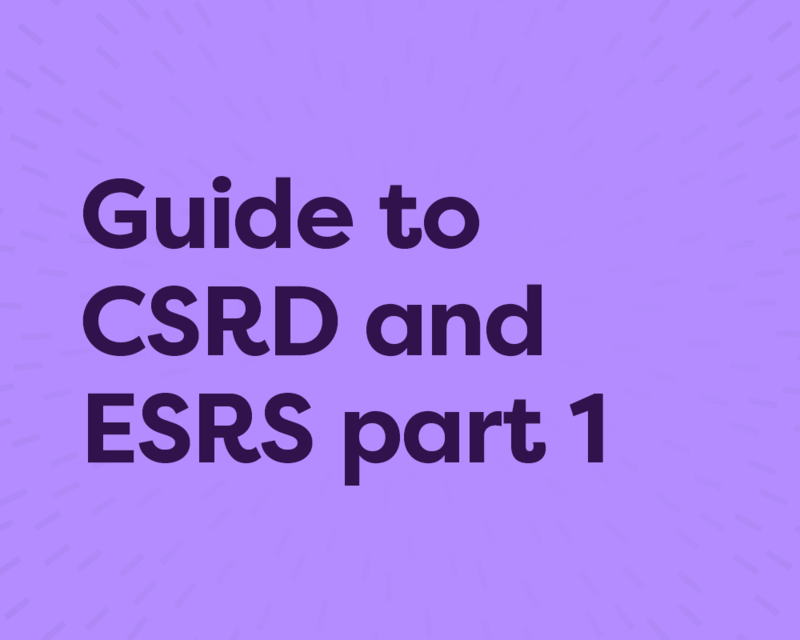The complete guide to CSRD and ESRS, article 1 of 2: CSRD and ESRS overview

In this article, Amy Hodgson, Consultant provides a useful overview of the Corporate Sustainability Reporting Directive (CSRD) and the European Sustainability Reporting Standards (ESRS) and how they relate to the wider disclosure landscape. For more detail on the ESRS standards and useful next step actions, see the second article in this two-part series here.
The European Commission committed to review provisions concerning non-financial reporting. To achieve this, The EU Green Deal was presented in December 2019. The Aim of the Green Deal is to create a modern, resource-efficient and net-zero economy by 2050. The CSRD (and therefore ESRS) forms part of the European Green Deal (they are two parts of the same legally binding framework around transparency in corporate sustainability reporting).
- CSRD is the overarching framework (the directive). Announced by the European Commission on 21st April 2021.
- ESRS (the ‘what and how’ detail of CSRD)- provide more detail around the requirements introduced by the CSRD and will be adopted by the EU as delegated acts. There are 12 standards. To understand more of the detail of these standards, read article 2. Reporting CSRD and ESRS: when what and how.
The CSRD replaces the NFRD. There are some differences between NFRD and CSRD:
The CSRD has been developed to replace the existing Non-Financial Reporting Directive (NFRD) in the European Union. Requirements are mandatory.
- Details that have been added: The CSRD expands upon the NFRD as it requires companies in scope to report on a wider range of topics and sub-topics, such as environmental, social and governance (ESG) issues, employee diversity, equality and inclusion (DEI) factors, and greenhouse gas (GHG) emissions.
- Assurance needed. companies will need to have assurance conducted on all their sustainability reporting. Limited assurance on reported information will be expected in 2024, however, assurance levels could progress to reasonable assurance in the coming years.
The ESRS clarifies what and how you should report to stakeholders under CSRD rules. The 12 individual standards which make up the ESRS are comprised of two general 'cross-cutting' standards and 10 'topical' standards. The scope and boundaries of these standards are discussed later in this report.
The purpose of the CSRD and its impact on businesses.
The key goal of CSRD is to provide the transparency that will help investors, companies, analysts and other stakeholders better evaluate EU companies’ sustainability performance as well as the related business impacts and risks. It aims to do this whilst striking the balance between limiting the burden on reporting companies. It enables companies to showcase their efforts in meeting the green deal agenda and bridging the gap between high and low-quality data.
Reporting costs will be reduced for companies in the medium and long term, due to reported information becoming more harmonised. Also, by having comparable and comprehensive sustainable information easily available, it supports companies to steer towards green investing.
The purpose of ESRS and how it relates to other international standards and frameworks
The ESRS standards set out the framework and methodology for reporting sustainability issues to meet the requirements of the wider Corporate and Sustainability Reporting Directive (CSRD). They target to improve transparency of non-financial information for investors and other stakeholders. They also aim to make non-financial reporting more consistent, reliable and comparable across the EU by requiring all disclosed sustainability information to be assured.
The ESRS are tailored to EU polices and align to existing international standards and frameworks including
- Global Reporting Initiative (GRI) Standard
- Task Force on Climate-Related Financial Disclosures (TCFD) recommendations.
But there are some big differences (which mean more work and might cause alarm to those who are unprepared!):
- The number of disclosures and datapoints that the CSRD mandates is considerably larger; potentially 85 disclosures and 1,100 datapoints (determined by materiality assessments).
- All information submitted must be assured.
We offer a number of services where we can support you with CSRD and ESRS standards. We can support you with gathering data, reporting, and assurance:
Give your stakeholders confidence in your sustainability data. We use our expertise in net zero, carbon accounting, and broader sustainability to provide an expert opinion on company disclosures for investor reporting, legislative compliance e.g CSRD) or benchmarking schemes (e.g GRESB).
Assurance and verification service
